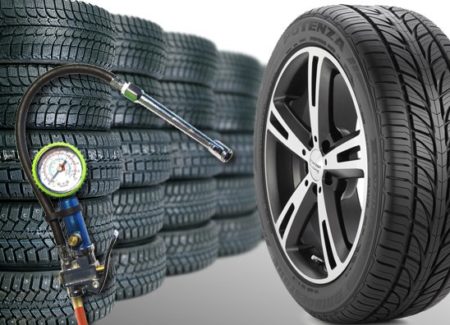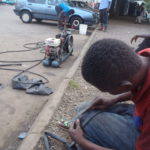
PROLOGUE
An experience I had with a vulcanizer paints a grim picture of the danger all motorist could be facing on daily basis. My vehicle has tyre pressure specification of 35 psi by the manufacturer. One day, I drove into a vulcanizers shop to pump up one of my tyres. After pumping, the vulcanizer got 35psi reading on his pencil tyre gauge.
I checked with my dial tyre gauge to confirm his reading and got a whopping 60 psi. I asked him to check again with his own gauge. Again he got 35 psi while mine still read 60 psi.
Why the huge differences in reading? Who was right?
FIRST BLUNDER: PENCIL GAUGE- AN OUTDATED TECHNOLOGY
The first blunder is that most vulcanizers use the worst tyre gauge- the Pencil Gauge that malfunctions easily when subjected to heavy usage.
How?
This gauge has a calibrated piston that is pushed by air that comes out from the tyre when connected to the valve stem. The extent to which the piston is pushed depends on the pressure in the tyre. The higher the pressure, the farther the piston will be pushed and the higher the reading.
Unfortunately, with heavy usage (as in everyday application by the vulcanizers), the hole through which air passes to activate the piston can be constricted by dust coming out from unprotected valve stem of the tyre and also by the rust due to moisture from the damp air coming out from the tyre.
With the air passage so narrowed, the amount of air passing through it no more corresponds to the air pressure in the tyre and so a faulty reading results. Worse still, when this happens, there is no way the user will know. It will still be giving reading but highly incorrect readings. That was the case with vulcanizer i had the encounter with.
After I explained to him why his gauge was the one at fault, he did not agree saying he had been using the gauge for long and never had any problems with it. Because of the seriousness of the issue, I had to prove to him conclusively that he was wrong and endangering the lives of innocent road users.
We had to get a brand new pencil gauge that has not been compromised by dust and rust. When it was used to gauge my tyre, the reading corresponded exactly to what I got with my gauge. He had no more argument and willingly complied with my demand to submit the dangerous gauge to me because I insisted that he must not use it again.
This type of gauge is also affected by temperature, humidity and altitude. So the readings got at different locations and weather conditions could differ substantially.
Not only that most vulcanizers use this type of gauge, they use it on daily basis and for years. The one used by the vulcanizer mentioned above had signs of abuse and overuse all over it. It is the same story North, East, West and South.
But why do the vulcanizers use this type of gauge? Essentially because it is the cheapest gauge in the market.
SECOND BLUNDER: ONE GUAGE FOR ALL PRESSURE RANGES
The second blunder is that not only that the vulcanizers use the pencil type of gauge, they use one gauge for all tyre pressure.
Using one gauge for all pressure measurements is a blunder. Why?
Every gauge has a calibration range designed for a certain pressure group and will only be accurate when used for such pressure group. Gauges are accurate when used to measure pressures whose values fall within the middle range of the gauge.
For instance, if you have a gauge with range 0-60psi, the middle range is 30psi. This gauge will be accurate for pressures whose values fall around 30psi. So pressures that should be measured with this gauge should be about 25-35psi.
Gauge of range 0-100psi should be used for pressures of 45-60psi or close. Gauge of range 0-160 should be used for pressures of 75-120psi. So if one uses a gauge not designed for a particular pressure group, one will get incorrect and misleading reading.
Unfortunately, the vulcanizers are innocently ignorant of this. Most of them use 0-160psi or 0-120psi gauges for all their tyre pressures, thinking that a wide ranged gauge should accommodate all the tyre pressures they measure. This sounds logical but grossly wrong and very dangerous.
You can imagine the combine effects of blunders 1 and 2 discussed above.
A NEED FOR A PERSONAL DIAL TYRE GAUGE
So, while one drives into the vulcanizers shop to fix ones tyre pressure problem, the vulcanizer inadvertently sets one up for the very problem one has gone to fix. The result is that almost all the vehicles that ply our roads have their tyres incorrectly inflated.
Just run a random check and you will confirm this. What a time bomb these vehicles could be. You can imagine what could have happened if I had driven away with 60psi pressure in a tyre designed for 35psi. Yet this is the fate that all motorists face every day. How many people have a personal gauge to confirm what the vulcanizer pumps into their tyres?
Since lives are involved, reliable tyre gauge cannot be compromised. The correctness of the tyre pressure is as good as the gauge used to measure it. So it is of vital importance that tyres are accurately gauged and pumped.
HIGHLY RECOMMENDED: FULLY GEARED PRECISION, BOURDON TUBE GUAGE
This therefore emphasizes the urgent need for vulcanizers to use accurate and reliable tyre gauges that should also have a way of telling when they malfunction otherwise one will be getting readings without being aware of it and that could mean disaster.
A reliable gauge is one that has a fully geared precision movement parts and with bourdon tube. Unlike the piston-plunger-type gauges (the pencil type), the bourdon tube movement is not affected by changes in temperature, humidity or altitude and so will give correct reading anywhere and anytime. When it malfunctions, the needle on the dial will indicate by erratic movement when engaged to gauge tyre pressure.
A sample of this gauge has been presented to the vulcanizers and fortunately, they are willing to use it. A vulcanizer should also have at least two gauges of different ranges (0-60psi and 0-100psi) as explained above.
Source: Thisdaylive.com







